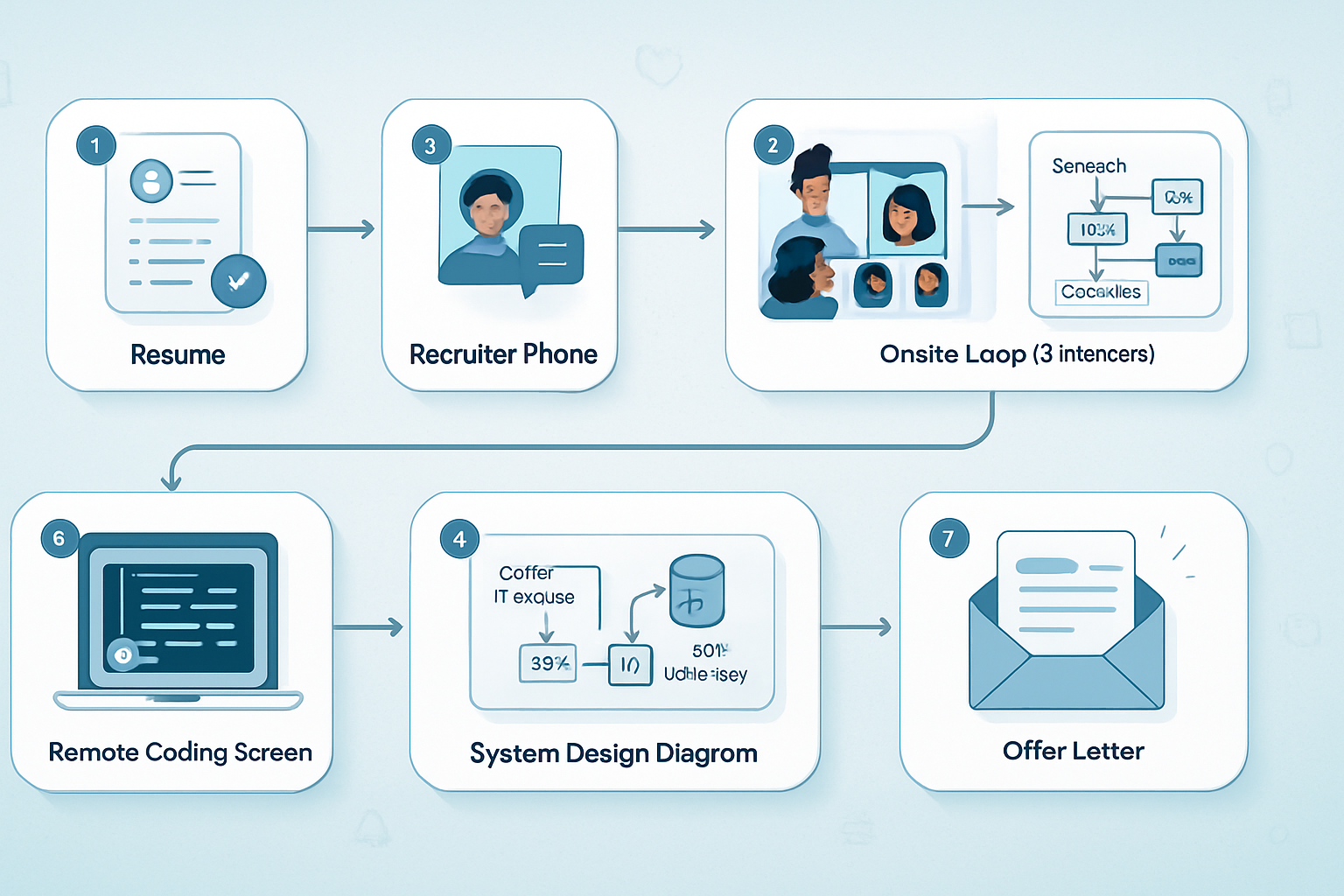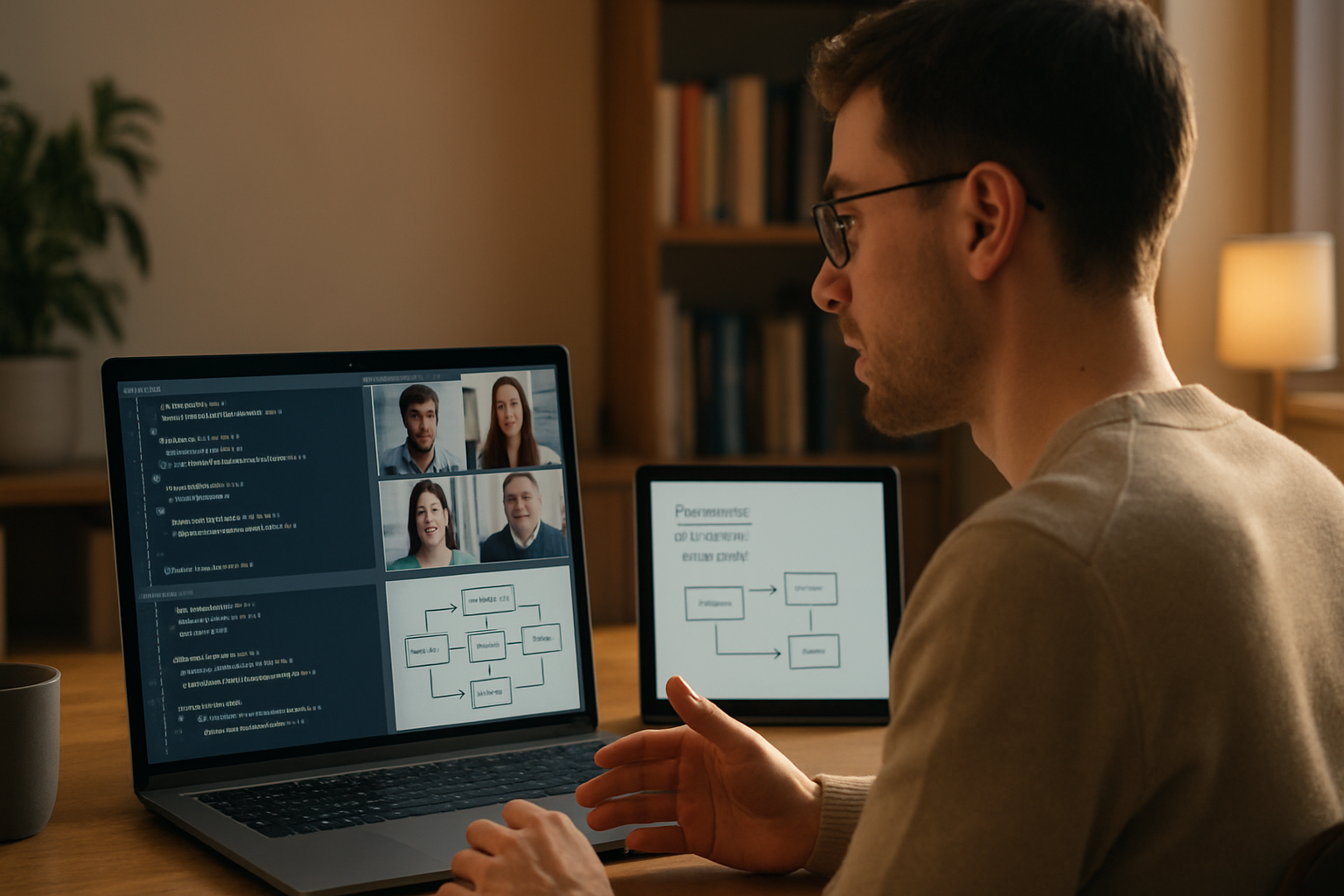· career · 6 min read
Decoding Meta's Interview Process: What You Need to Know
An insider's guide to Meta's multi-stage interview process - what to expect at each stage (recruiter screen, technical phone screens, onsite loop), how candidates are evaluated, role-specific differences, timeline, and practical preparation strategies.

Why decode Meta’s interview process?
Meta (formerly Facebook) is one of the most sought-after employers in tech. The process can feel opaque and intense - multi-stage, with different interview formats and evaluation criteria. This guide breaks down what actually happens at each step, why interviewers ask what they do, and how you can prepare efficiently.
Note: Meta evolves its hiring practices periodically. The flow below is representative of the common end-to-end experience for software engineering and related roles as of the mid-2020s.
The high-level flow (what to expect)
- Application / Referral
- Recruiter screen (phone) - role fit, salary expectations, basic logistical checks
- Technical screens (1–2 remote/phone rounds) - coding on a shared editor/whiteboard
- Onsite loop (now often virtual) - 3–5 interviews: coding, system design, behavioral/leadership
- Hiring committee & compensation calibration
- Offer, background check, negotiation
This flow can vary by role (Product Manager, Data Scientist, Research Scientist, Infrastructure, etc.) and level. Internships and early-career roles have shorter flows with fewer stages.
Stage-by-stage breakdown
1) Application & Recruiter Screen
- What happens: Recruiter confirms your resume details, role interest, work authorization, and compensation expectations. They also give logistics about interview format and schedule.
- How to prepare: Have a crisp 30–60 second pitch of your background, major accomplishments, and what you want. Make sure your resume has measurable impact examples.
2) Technical Screens (Phone / Remote)
- Typical format: 45–60 minute remote session with a hiring manager or peer. You’ll use a shared editor (e.g., CoderPad, HackPad, or Google Docs) to solve coding problems.
- Focus: Data structures & algorithms, coding correctness, clarity of thought, and communication.
- What interviewers look for: Problem decomposition, choice of data structures, algorithmic complexity, testing & edge-case handling, code quality.
- Example problems: array manipulation, two-pointer, sliding window, binary tree traversal, dynamic programming (medium difficulty on LeetCode).
3) Onsite Loop (3–5 interviews)
Most common components:
- Coding interviews (2+ rounds): 45–60 minutes solving 1–2 problems. Expect problems slightly harder than the phone screen (medium–hard).
- System design (for mid / senior levels): 45–60 minutes to design scalable systems, trade-offs, capacity planning, API choices, storage, consistency models.
- Behavioral / Leadership interview: Questions about teamwork, conflict resolution, impact, and Meta’s leadership expectations.
- Role-specific interviews: For PMs - product design and analytical questions; for DS - statistics and modeling; for infra - low-level design and performance.
What to focus on in each:
- Coding: Live problem-solving, think aloud, iterate, write correct code, test with examples.
- System design: Ask clarifying questions, sketch components, justify trade-offs, address scaling, reliability, and monitoring.
- Behavioral: Use STAR (Situation, Task, Action, Result) to structure answers and emphasize measurable impact.
4) Hiring Committee & Calibration
After your interviews, interviewers submit feedback. Meta’s hiring committee (a cross-functional group) reviews the packet to decide on hire/no-hire. The committee is meant to reduce bias and enforce bar-raising consistency.
Also: compensation gets calibrated by a compensation team based on role, level, location, and internal bands.
5) Offer & Negotiation
If approved, a recruiter shares the offer. You may negotiate base, equity, and sign-on. Expect a background check and typical onboarding steps after accepting.
How candidates are evaluated - what matters most
- Problem-solving ability and fundamentals (algorithms, data structures)
- System design and architecture knowledge for senior and infrastructure roles
- Impact and ownership demonstrated in past work (projects, scale, metrics)
- Communication, collaboration, and leadership qualities
- Culture fit and alignment with role expectations
Interviewers typically rate across dimensions and provide written notes with examples; these are key inputs for the hiring committee.
Role-specific differences
- Software Engineer (IC3–IC5): heavy emphasis on coding during early rounds; system design introduced at IC4+. Expect greater focus on code correctness and speed for IC3.
- Senior Engineers (IC5+): larger emphasis on system design, architecture, and leadership (mentorship, cross-team work).
- Product Managers: product sense, analytics, technical fluency, and stakeholder management.
- Data Science / ML roles: statistics, modeling, experimental design, and coding (Python/R) for data work.
- Research / Applied Research: depth in theory, papers, and experiments.
Concrete preparation plan (8-week plan, adaptable)
Weeks 1–2: Fundamentals
- Review arrays, strings, hashing, linked lists, stacks, queues, trees, graphs, heaps.
- Resource: “Cracking the Coding Interview” and LeetCode practice - aim for easy→medium problems.
Weeks 3–5: Focused practice
- Solve medium-level LeetCode problems daily; simulate timed sessions.
- Start mock interviews with peers or platforms (Pramp, Interviewing.io).
- Work on writing clean code and explaining decisions aloud.
Weeks 6–7: System design & behavioral
- For senior roles, practice system design: design a URL shortener, news feed, chat service.
- Resources: “Grokking the System Design Interview” (Educative), Designing Data-Intensive Applications by Martin Kleppmann.
- Draft 6–8 STAR stories that cover leadership, difficult trade-offs, big wins, failures, and mentorship.
Week 8: Mock loop & polish
- Run a full mock loop: 2 coding + 1 design + 1 behavioral.
- Work on speed-practice 45-minute problem cycles.
Recommended resources:
- Meta Careers overview: https://www.metacareers.com/
- LeetCode practice and company-tagged problems: https://leetcode.com/
- “Cracking the Coding Interview”: https://www.careercup.com/book
- “Grokking the System Design Interview” (Educative): https://www.educative.io/courses/grokking-the-system-design-interview
- Designing Data-Intensive Applications: https://dataintensive.net/
Interview-day practical tips
- Clarify requirements before coding. Ask about input sizes, invariants, and expected behaviors.
- Think out loud. Interviewers judge approach and trade-offs, not just the final code.
- Start with a brute-force solution if needed, then optimize.
- Write tests and handle edge cases (null inputs, empty lists, duplicates).
- For design: sketch the high-level architecture, then dive into components, data model, and bottlenecks.
- For behavioral: be concise, quantify impact, and be honest about lessons learned.
Common pitfalls to avoid
- Silence: not speaking while solving - interviewers can’t help if you’re quiet.
- Premature optimization: don’t overcomplicate before confirming constraints.
- No testing: failing to run through sample cases or consider edge cases.
- Poor trade-off justification in design interviews.
- Recycling generic behavioral answers without concrete outcomes.
Sample questions (by interview type)
- Coding (medium → hard): “Given an array of integers, find the length of the longest subarray with sum = k.”; “Serialize and deserialize a binary tree.”; “Given k lists of sorted integers, merge them into a single sorted list.”
- System design: “Design Facebook News Feed (or real-time feed) for 1B users.”; “Design a chat/messaging system with delivery guarantees.”
- Behavioral: “Tell me about a time you disagreed with your manager.”; “Describe a project where you drove impact from idea to production.”
(Use these as practice prompts; search company-specific questions on LeetCode and Glassdoor.)
Timeline expectations
- From recruiter screen to onsite: 1–4 weeks (depends on scheduling and role urgency)
- From onsite to offer: 1–3 weeks (includes hiring committee review and comp calibration)
- Total: often 3–8 weeks, though it can be shorter or longer.
After the interview: feedback and next steps
- At Meta, feedback cycles can be quick, but you may need to wait while the hiring committee compiles decisions.
- If you receive constructive feedback, incorporate it into future prep. If rejected, consider reapplying after significant new impact (usually 6–12 months depending on role).
Final tips - stand out the right way
- Focus on clarity and measurable impact on your resume and during interviews.
- Prepare STAR stories anchored to metrics (e.g., ”% latency reduced” or ”% engagement increased”).
- Practice communicating trade-offs in design questions - that’s often what separates good from great candidates.
- Use mocks and time yourself; interviewing is a skill that improves with deliberate practice.
References & further reading
- Meta Careers: https://www.metacareers.com/
- LeetCode: https://leetcode.com/
- “Cracking the Coding Interview”: https://www.careercup.com/book
- “Grokking the System Design Interview” (Educative): https://www.educative.io/courses/grokking-the-system-design-interview
- Designing Data-Intensive Applications by Martin Kleppmann: https://dataintensive.net/



